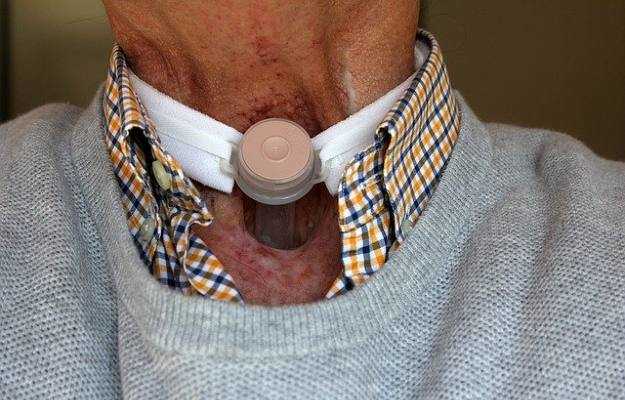The larynx, also known as the voice box, helps us produce sound when we speak. It is a part of the throat—it is present between the base of the tongue and the windpipe (trachea).
The larynx consists of vocal cords that vibrate and make a sound when air is passed through them. The sound echoes through the pharynx (food pipe), nose and mouth and then comes out as a voice. There are three parts of the larynx:
- Supraglottis: This is the upper part of the larynx which starts from above the vocal cords and includes the epiglottis (a leaf-like structure which works as a valve to prevent food and liquids from entering the windpipe).
- Glottis: This is the middle part of the larynx. The vocal cords are located in this part.
- Subglottis: This is the lower part of the larynx which starts below the vocal cords and ends above the trachea (windpipe).
There is a horseshoe-shaped structure behind and around the larynx which is called the hypopharynx. The hypopharynx is essential for the larynx as it directs food into the food pipe (oesophagus). When a person swallows, the larynx, hypopharynx and oesophagus all work together to make sure food goes right into the stomach. A dysfunction in any of these structures can cause the food to enter the lungs, leading to a chest infection.
The larynx has three important functions:
- The larynx helps the air to reach the lungs whenever we breathe
- The larynx helps in making a sound by vibrating the vocal cords
- The larynx includes the epiglottis which covers the windpipe while we eat and drink to prevent the entry of food and drinks into the lungs
Laryngeal cancer is one of the types of cancer. It is characterized by an uncontrollable growth of abnormal cells in the larynx, especially in the squamous cells that form the inner lining of the larynx. Around 60% of all laryngeal cancers occur in the glottis, 35% in the supraglottis, and the rest in the subglottis.
Laryngeal cancer is further divided based on the extent to which cancer has spread and the TNM classification (tumour, node and metastasis). Laryngeal cancer can spread to the other parts of the body as well.
The symptoms of laryngeal cancer are hoarse voice, pain and difficulty in swallowing, persistent cough and sore throat, ear pain and in severe cases difficulty breathing.
The treatment of laryngeal cancer requires a multifactorial approach which involves surgical removal of infected parts, chemotherapy, radiotherapy, immunotherapy and biological therapy. Patients undergoing surgery may require some procedures to regain their voice.
Regaining voice after laryngeal cancer treatment
In the case of total laryngectomy, the patient will not be able to speak properly due to the absence of vocal cords. The patient's caregiver needs to take extra care to ensure that the patient gets adequate support throughout the recovery period—it can be frustrating to lose something so central as their voice, which the patient would have lived with their whole life.
Once the throat is healed, the person can be taken to a speech and language therapist (SLT) to help restore their voice. The doctors may use voice prosthesis which is an artificial valve that is implanted into the neck of the patient. When the person wishes to speak, they need to cover their stoma and breathe out through the valve. This valve produces noise which can be used to speak out words just like the natural way. However, the voice would be lower-pitched than the normal voice. This prosthesis can be placed in the same surgery where the surgeon would remove the larynx.
Another technique that the SLT might use is the oesophageal speech technique. In this, the person is asked to push air through the oesophagus (food pipe). While the air moves through the oesophagus, it vibrates and produces a voice.
The SLT may also use another device called the electrolarynx which is a battery-operated electrical device which vibrates and produces sound. The device is held under the chin and as the person moves their mouth and lips, the vibrations are translated into words.
Taking care of open wounds after laryngeal cancer treatment
In the case of total laryngectomy, the surgeon creates a permanent hole in the patient's throat to help them breathe—this hole is called a stoma. It is quite common for the stoma to produce an excess amount of mucus during the first few months of healing. This excessive mucus can make it difficult for the patient to breathe.
A caregiver needs to make sure that the stoma is cleaned at least once a day or else it would become crusty and pose a risk of infections. In some cases, the doctors may place a tube attached to the stoma to help the patient breathe. Once the mucus production settles down, the tube is removed from the stoma.
Patients need to remember that they will now need to cover their stoma with a tissue when they cough or sneeze, rather than covering their mouth or nose. This is because mucus or saliva will come out of the stoma.
In case the patient is unable to do so themselves, a caregiver must cover the stoma whenever the patient sneezes or coughs as the patient's saliva and mucus can come out of the stoma.
Radiotherapy for laryngeal cancer
In radiotherapy, doctors use controlled doses of high-energy radiation to destroy the cancerous cells. This treatment is mostly used in the early stages of cancer or after cancer surgery to prevent the return of cancerous cells.
Sometimes radiotherapy is given along with chemotherapy. In radiotherapy, the beams are precisely targeted to the larynx. The patient is made to wear a plastic mask that holds the head in the right position throughout the session. Usually, hyperfractionated radiation therapy is used for the treatment of laryngeal cancer. In hyperfractionated radiation therapy, a smaller dose of radiation is divided into two doses and thus the treatment is given twice a day.
The course of treatment usually lasts for three to seven weeks. The beams kill the cancerous cells, but they also affect the healthy tissues of the body. As a result, the patient may complain of various side effects such as sunburn-like rashes, mouth ulcers, dry mouth, loss of taste, loss of appetite and fatigue. For these, the doctor may give the patient medicines like anaesthetic gels, artificial saliva and betadine solution for ulcers, loss of taste and sore throat.

 Doctors for Laryngeal cancer
Doctors for Laryngeal cancer 


















